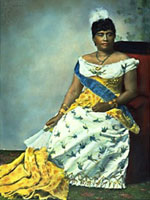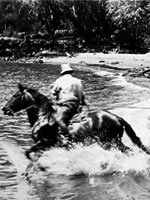Zooarchaeology
Colonial Williamsburg's curator of zooarcheaology, Joanne Bowen, talks about how the bones left behind from kitchen waste can reveal information about the foodways of people from colonial days through the 19th century.
Colonial Williamsburg's curator of zooarcheaology, Joanne Bowen, talks about how the bones left behind from kitchen waste can reveal information about the foodways of people from colonial days through the 19th century.
Louise Kale, director of the Historic Campus, outlines the history and restoration of the College of William and Mary's Wren Building, completed in 1700.
Inspiration intersects with means in a partnership that resurrects a city. Character interpreter Ed Way discusses W.A.R. Goodwin, founder of Colonial Williamsburg.

[FREE AND SUBSCRIPTION]
These 22 exhibits present free access to a wealth of texts and images on a variety of subjects dealing with 19th-century American history. Each section provides illustrations, articles, editorials, and overviews. Materials include four exhibits on politics and elections, including the impeachment of Andrew Johnson. Six exhibits deal with race and ethnicity, including slavery and Chinese Americans. Three exhibits offer material on business and consumer culture, such as advertising history and tobacco.
Additional exhibits include "The American West"; "A Sampler of Civil War Literature"; "Russian-American Relations, 18631905"; and "The World of Thomas Nast." A subscription-based website presents the entire run of Harper's Weekly. With free registration, Nineteenth-Century Advertising presents an archive of 40,000 advertisements that appeared in Harper's Weekly.
The Oklahoma Historical Society, with its affiliate, the Jim Thorpe Foundation, preserves and displays the former home of the 1912 Olympian containing exhibited artifacts from Jim Thorpe and his family.
The home offers tours.
When the Territory of Kansas was created in 1854, its boundary was set at the 37th parallel. When Texas came into the union, being a slave state, it could not extend its sovereignty over any territory north of 36° 30' North. The Missouri Compromise specified that territory North of this line would be free-state territory. This situation left a narrow strip of land 34 miles wide between Kansas and Texas extending from the 100th parallel on the East to the 103rd parallel on the West, a total of 168 miles in length. Since the area was claimed by no state, it was soon given the name of No Man's Land. In the mid-1880s, drought and depression caused many to leave heavily mortgaged farmlands in western Kansas. They became squatters in what was in time to become the Oklahoma Panhandle. While the settlers could not receive legal title to the land they settled, precedents in other territorial regions indicated the Federal Government would in time recognize "Squatter's Rights." No Man's Land Museum chronicles the struggles of the settlers as they established their own government and developed their communities.
The museum offers exhibits.
The Museum houses items from actor Tom Mix's personal collection, providing a glimpse into the life of one of Oklahoma's famous figures.
The museum offers exhibits.
The 30-acre Belle Meade Plantation holds the Federal-style 1853 Belle Meade mansion and seven other historic buildings, including a stable and carriage house. The plantation was founded by John Harding in 1807. Harding was a devoted thoroughbred breeder and racer, as were many gentlemen from the South during his time. Tenneessee thoroughbred breeding became less common after the Civil War, as the state saw extensive troop movement. The mansion facade includes Greek Revival elements added in 1853, and the interior is furnished with 19th-century pieces. The plantation owned more slaves than the majority of antebellum Nashville plantations. Some of these slaves served as horse grooms and jockeys.
The plantation offers period rooms, 45-minute guided mansion tours, five educational program options for students, summer camps, home school days, traveling trunks, toddler programs, a student book club with online interactive activities, a junior docent program, culinary guided tours, and a restaurant. Reservations are required for groups of 15 or more. The second floor is not wheelchair accessible.

What happened to the royal family of Hawaii after the U.S. took over?
Hawaii's monarchy was limited by the 1887 Constitution of the Kingdom of Hawaii, which King David Kalakaua (18361891) signed under threat of force, and which was therefore often known as the Bayonet Constitution. It established a constitutional monarchy much like Britain's, but also transferred power through a redefinition of the electoral franchise to an elite class of American, European, and native Hawaiian landowners.
When Kalakaua died in 1891, his sister Lili'uokalani (18381917) succeeded him on the throne. Soon she made plans to restore the monarchy's veto power and other features of the pre-1887 Constitution. A group of American and European residents, in opposition to the Queen, organized themselves and solicited protection from U.S. Marines and sailors, which U.S. Government Minister John Stevens provided. Queen Lili'uokalani was deposed on January 14, 1893, and a provisional government was formed.
On February 1, Stevens proclaimed Hawaii a protectorate of the United States. On July 4, 1894, the Republic of Hawaii was founded and Sanford Dole became its President. A brief effort at the beginning of 1895 to restore the monarchy and Lili'uokalani to the throne was thwarted. Arrested and convicted for playing a part in the failed effort, Lili'uokalani was confined to house arrest in Iolani Palace, where she spent much of her time writing songs. She abdicated her throne eight months later, in return for the commutation of the sentence of her fellow conspirators. Later, she would write that her signature on the abdication agreement, which she signed "Lili'uokalani Domonis" (she had married Robert Domonis), invalidated it because, as a monarch, she had never acted under that name, but only "Lili'uokalani." Be that as it may, the government pensioned her off and she retired to her palatial home, where she died, at age 79.
Hawaii was a united kingdom under a single monarch only for eighty years, from 1810, when Kamehameha I (17381819) brought all the islands under his control, to the time when the monarchy became defunct under Lili'uokalani. During that time, the rules of succession evolved, to include not only the members of the families of Kamehameha and Kalakaua, but also adopted sons and daughters (Lili'uokalani had three) and members of a noble class recognized by Kamehameha as eligible to be rulers. Because the kingdom ended more than a century ago and because all these families have continued to proliferate, there are currently a large number of people who might be considered as heirs or pretenders to the Hawaiian throne, were it ever to be revived.
William Adam Russ, The Hawaiian Revolution (189394) (Selinsgrove, Pa.: Susquehanna University Press, 1992).
Ralph S. Kuykendall, The Hawaiian Kingdom, 18741893 (Honolulu: University of Hawaii Press, 1967).
Gavan Daws, Shoal of Time: A History of the Hawaiian Islands (Honolulu: University of Hawaii Press, 1974).
Norris W. Potter et al, History of the Hawaiian Kingdom (Honolulu: Bess Press, 2003).
George S. Kanahele, Emma: Hawai'i's Remarkable Queen (Honolulu: The Queen Emma Foundation, 1999) Liliuokalani, Hawaii’s Story (Rutland, Vt.: Tuttle, 1964).

These 29 collections document the history of Hawaii and Micronesia from 1834 to the 1990s. "Annexation of Hawai'i," for example, contains thousands of pages of documents concerning the U.S. plan to annex Hawaii, realized in 1898. Materials include the 1,437-page Blount Report of 189495, initiated by President Grover Cleveland on the history of relations between the U.S. and Hawaii and the planned annexation; Congressional debates on the Hawaii Organic Act, passed in 1900 to establish a territorial government; and Hawaiian anti-annexation petitions and protest documents from 189798.
"Hawaii War Records" presents 880 photographs documenting the impact of World War II on Hawaii and its people. The "Trust Territories of the Pacific Islands" photo archive provides 52,000 photographs on programs in education, health, and political and economic development in the 2,100 islands of Micronesia administered by the U.S. from 1947 to 1994. The website also includes a collection of 16 Hawaiian-language newspapers.